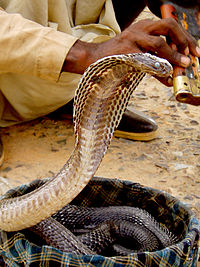
Cobra
Did you know...
SOS Children made this Wikipedia selection alongside other schools resources. With SOS Children you can choose to sponsor children in over a hundred countries
A cobra (pronunciation) is a venomous snake of family Elapidae, of several genera, but particularly Naja. (Non-cobra elapidae include the taipans, brown snakes, tiger snakes, fierce snakes, coral snakes, mambas, and sea snakes.) Cobras generally inhabit tropical and desert regions of Asia and Africa.
Appearance and description
The cobra's most recognizable feature is its hood, a section of its neck which it can flatten outwards in a threat display. Note that most snakes can flatten their necks to some degree; cobras are only more adept. Cobras come in varying colors from black or dark brown to yellowish white. Elapidae cannot fold their fangs down, as Viperidae can, so their fangs are generally shorter. Most cobras are quite large, reaching on average 1.2–2.5 m (3.9-8.2 ft) long.
Cobra is the Portuguese (and old Galician) common name for a snake; it came from late Latin colobra (from the classical Latin coluber, colubra). When Portuguese navigators arrived on the coasts of Africa and South Asia in the 16th century, they named the cobra "cobra-capelo", or "hood-snake"; from this compound, the name entered Spanish, French, English, and other European languages. Today, mainly in Brazil, cobras are known basically as najas.
They kill their prey by injecting a neurotoxin through their hollow fangs. The neurotoxin blocks the synaptic communication between the victim's neurons and muscles, thus stopping movement and muscle control.
The cobra's predators include the mongoose, the honey badger and some raptors.
Types of cobra
The most common cobra is the Indian or Spectacled cobra Naja naja, native to the Indian subcontinent and associated with snake charming there. The Black cobra, found in Pakistan and North India, is generally considered to be a sub-species.
The second most common cobra species is the Monocled cobra, Naja kaouthia, widespread in Asia.
In addition to a deadly bite, the Spitting cobra can incapacitate larger would-be predators by spraying venom into their eyes. This is extremely painful and can cause permanent blindness, but if washed out promptly rarely causes permanent damage.
The King cobra is ophiophagous; it feeds almost entirely on other snakes, even venomous ones, although it sometimes preys on small rodents and birds. It will only attack humans if provoked or in other extreme circumstances that threaten its survival. If not treated, a king cobra's bite can kill a person in just half an hour. King Cobras may reach up to 5.2m (17.1ft) in length, making them the largest venomous snakes in the world.
Cobra venom
The snake will only attack a human if provoked or in other extreme circumstances which threaten its survival. Furthermore, for a dangerously venomous snake, the cobra's strikes are quite slow when compared to the extremely rapid strikes of such species as rattlesnakes. Additionally, not all bites result in envenomation and in the case of the Cobra the amount of "blank" strikes may be quite high: in one series of recorded bites in Malaysia only 55% of strikes have included envenomation. Cobra bites are fatal in about 10% of human cases. However, as with any venomous snake, a bite from a cobra should be treated as a potentially fatal injury and medical attention should be sought immediately. As with all elapids, the venom of cobras is highly neurotoxic and dangerous. Therefore, any cobra bite must be regarded as life-threatening and professional medical assistance should be immediately sought. Early symptoms of a bite include ptosis, diplopia , dysphagia, and dizziness, followed by progressive respiratory muscle weakness, ultimately requiring endotracheal intubation. Cobra venom is a postsynaptic neurotoxin. It works by stopping the acetylcholine molecules in the diaphragm muscle from interacting. Without treatment death from respiratory failure may occur as early as 30 minutes after being bitten.
Standard treatment involves the use of antivenin. Additionally, it is possible to support bite victims via mechanical ventilation, using equipment of the type generally available at hospitals. If too far away from a hospital, doctors prefer the "suck and spit" formation. Such support should be provided until the venom is metabolised and the victim can breathe unaided. If death occurs it takes place approximately 6 to 12 hours after the cobra bite. Cause of death is respiratory failure or suffocation caused by complete paralysis of the diaphragm.
Rhythm
Indian snake charmers, also known as "saperas" play a harmless trick on spectators. A cobra rises from its basket and sways in time with the music, apparently hypnotized. In fact, as far as the snake is concerned, the music is irrelevant - the cobra can't hear a thing. What prompts it to perform is the snake charmer's clever manipulation of the cobra's natural tendencies. When suddenly thrust into the open air from the darkness of the basket, the snake rises up and spreads its hood, its normal reaction to a threat. It sees the swaying pipe and mistakes it for another snake. That error, together with the charmer's movements in time with the music, holds the snake's attention. As the charmer moves the pipe, so the cobra bobs its head.
Captive cobras held by snake charmers
Snake charmers are known to de-fang, or puncture the poison glands of the cobras using hot iron rods. This makes the cobras less aggressive and docile during their performances. Some snakes, including cobras, can live without food for 4 to 6 weeks. This is also the time span they will survive in captivity with snake charmers. Such injured snakes in the possession of these charmers will ultimately die of hunger or infection.



